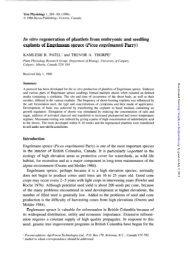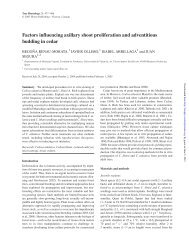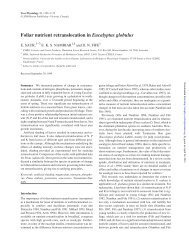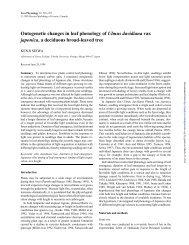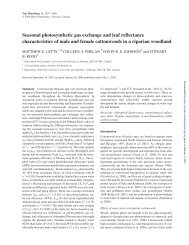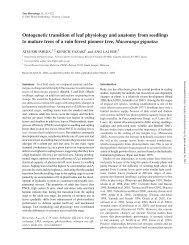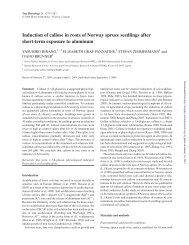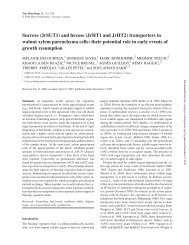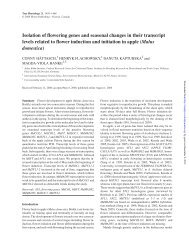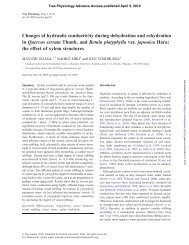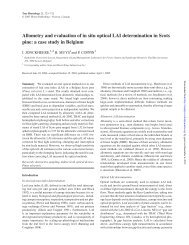Cryopreservation of Quercus suber somatic embryos - Tree Physiology
Cryopreservation of Quercus suber somatic embryos - Tree Physiology
Cryopreservation of Quercus suber somatic embryos - Tree Physiology
Create successful ePaper yourself
Turn your PDF publications into a flip-book with our unique Google optimized e-Paper software.
1842 FERNANDES ET AL.<br />
sativa L., Shibli et al. 2001) and <strong>somatic</strong> <strong>embryos</strong> and embryogenic<br />
masses (e.g., C<strong>of</strong>fea canephora Pierre ex Froehn,<br />
Tessereau et al. 1994; Citrus sp., Malik et al. 2006; Melea sp.,<br />
Scocchi et al. 2007) but its use has never been reported for the<br />
Fagaceae. Therefore, our first objective was to develop a<br />
non-toxic, inexpensive protocol for cryopreservation by encapsulation-dehydration<br />
for cork oak <strong>somatic</strong> <strong>embryos</strong>.<br />
<strong>Cryopreservation</strong> exposes plant material to stresses that<br />
may affect its genetic stability (see review by Panis and Lambardi<br />
2005). Therefore, our second objective was to evaluate<br />
the genetic stability <strong>of</strong> the cryopreserved <strong>somatic</strong> <strong>embryos</strong> after<br />
thawing based on three techniques—flow cytometry<br />
(FCM), amplified fragment length polymorphisms (AFLP)<br />
and simple sequence repeats (SSR). Flow cytometry (FCM),<br />
which has been used to provide a check on ploidy <strong>of</strong> in vitro<br />
cultures <strong>of</strong> hardwood species (e.g., Conde et al. 2004, Pinto et<br />
al. 2004, Loureiro et al. 2005, 2007b, Leal et al. 2006), was<br />
used to assess the ploidy <strong>of</strong> cryopreserved <strong>somatic</strong> <strong>embryos</strong> after<br />
thawing. We also checked for somaclonal variability based<br />
on amplified fragment length polymorphisms (AFLP) and<br />
simple sequence repeats (SSR). The AFLP is a sensitive<br />
multi-locus fingerprinting technique (Wilkinson et al. 2003)<br />
that has been used to assess genetic diversity in the <strong>Quercus</strong><br />
genus (Hornero et al. 2001, Coart et al. 2002, Ishida et al.<br />
2003) and to evaluate the genetic stability <strong>of</strong> cryopreserved<br />
material <strong>of</strong> hardwood species (Liu et al. 2004). The<br />
microsatellite (SSR) marker technique has previously been<br />
used to evaluate genetic stability in in vitro cultures (Liu et al.<br />
2008) and in cork oak emblings (Lopes et al. 2006) based on<br />
primers developed for other <strong>Quercus</strong> species (e.g., Isagi and<br />
Suhandono 1997, Steinkellner et al. 1997, Kampfer et al.<br />
1998).<br />
Materials and methods<br />
Plant material and growth conditions<br />
We studied <strong>somatic</strong> embryogenic clusters (2.5-mm diameter<br />
on average) at the globular stage induced from an ~80-year-old<br />
<strong>Quercus</strong> <strong>suber</strong> (genotype G0) tree, as reported by Pinto et al.<br />
(2002). The cultures had been maintained for 5 years in petri<br />
dishes in controlled-environment culture rooms with a constant<br />
temperature <strong>of</strong> 23 ± 2 °C and a 16-h photoperiod at<br />
99 µmol m –2 s –1 photosynthetic photon flux (Osram L,<br />
36W/31830, cool white, fluorescent tubes). The plant material<br />
was subcultured every 4 weeks on standard solid MS medium<br />
(Murashige and Skoog 1962), supplemented with 30 g l –1 sucrose<br />
and 2.5 g l –1 Gelrite. The pH <strong>of</strong> the medium was 5.8 before<br />
autoclaving. All plant culture products were obtained<br />
from Duchefa.<br />
<strong>Cryopreservation</strong> after encapsulation and dehydration<br />
Somatic embryo clusters were isolated and subsequently encapsulated<br />
as described by Grout (1995). The encapsulation<br />
solutions—0.1 M CaCl2 and 3% (w/v) alginate solution—<br />
were prepared in standard MS medium, to which 0.5 M sucrose<br />
was added before forming the beads. Embryo clusters<br />
TREE PHYSIOLOGY VOLUME 28, 2008<br />
were loaded in the 3% (w/v) alginate solution and then mixed<br />
with 0.1 M CaCl2 solution to form beads with a diameter <strong>of</strong><br />
3–4 mm (each bead contained a single embryogenic cluster).<br />
The beads were incubated for 3 days in sucrose-enriched (0.7<br />
M) MS liquid medium before desiccation. Beads were desiccated<br />
in open petri dishes placed in the airflow <strong>of</strong> a laminar<br />
flow bench. Mass loss was monitored with an analytical balance<br />
and the water content calculated (Verleysen et al. 2004).<br />
Two final water content (WC) values were chosen: 25%<br />
(CRY25) and 35% (CRY35), based on literature values (Niino<br />
and Sakai 1992, Hirata et al. 1996, Gonzalez-Arnao et al.<br />
2000). For cryopreservation, beads were placed in cryotubes<br />
(10 per vial), frozen in liquid nitrogen (direct immersion) and<br />
stored for 24 h. Samples were thawed by immersing vials in a<br />
water bath (38 °C for 2 min after which time no ice crystals<br />
were visible).<br />
Viability <strong>of</strong> both frozen and non-frozen (controls) encapsulated<br />
and desiccated explants was determined following<br />
rehydration in 1.0 M sucrose in liquid MS medium for 1 h, followed<br />
by culture on solid MS medium.<br />
Flow cytometry<br />
Nuclear suspensions <strong>of</strong> <strong>somatic</strong> <strong>embryos</strong> were prepared according<br />
to Galbraith et al. (1983) as described by Loureiro et<br />
al. (2005). Briefly, the sample and the Glycine max cv. Polanka<br />
reference material (standard with 2C = 2.50 pg nuclear DNA,<br />
Dolezel et al. 1992; provided by Jaroslav Dolezel, Institute <strong>of</strong><br />
Experimental Botany, Olomouc, Czech Republic) were homogenized<br />
in Woody Plant Buffer (Loureiro et al. 2007a). The<br />
homogenate was filtered through 80-µm nylon mesh and then<br />
50 µg ml –1 <strong>of</strong> propidium iodide (Fluka) and 50 µg ml –1 <strong>of</strong><br />
RNAse (Sigma) were added. Samples were analyzed in a<br />
Coulter EPICS-XL flow cytometer (Coulter Electronics,<br />
Hialeah, FL). The 2C nuclear genome size (pg) <strong>of</strong> <strong>Quercus</strong><br />
<strong>suber</strong> was calculated as:<br />
0 1peak<br />
mean<br />
2CDNA = 250pg<br />
peak mean<br />
Q <strong>suber</strong> G G<br />
. /<br />
.<br />
G. max G / G<br />
0 1<br />
Three replicates were analyzed per treatment (control,<br />
CRY25 and CRY35), and at least 5000 nuclei were analyzed<br />
per sample. To calculate total base pairs, we assumed that 1 pg<br />
<strong>of</strong> nuclear DNA contains 978 Mbp (Dolezel et al. 2003).<br />
DNA extraction<br />
Thawed <strong>somatic</strong> <strong>embryos</strong> that had been encapsulated, dehydrated<br />
and cryopreserved (CRY25 and CRY35) and control<br />
<strong>somatic</strong> <strong>embryos</strong> that had been encapsulated and dehydrated<br />
but not frozen were immersed in liquid nitrogen and<br />
lyophilized for 48 h. Dried material (20 mg) was ground and<br />
DNA was isolated according to the Qiagen extraction kit procedure.<br />
This method yielded up to 20 µg <strong>of</strong> genomic DNA per<br />
extraction. The DNA concentration was determined relative to<br />
uncut lambda DNA, on 1.5% agarose gels.<br />
Downloaded from<br />
http://treephys.oxfordjournals.org/ by guest on March 21, 2013



